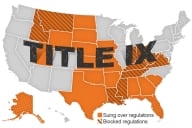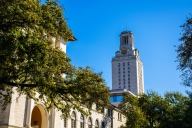You have /5 articles left.
Sign up for a free account or log in.
NEW YORK – Talk about the boom in adjunct union growth dominated many of the conversations at the annual meeting here of the National Center for the Study of Collective Bargaining in Higher Education and the Professions this weekend. In addition to a series of formal panels on adjunct organizing, the topic was discussed more informally at other sessions, in hallways and over lunch tables. Much of the talk was congratulatory and acknowledged the gains adjuncts have made through collective bargaining agreements with their institutions, or those still in the works. But there also were more reflective moments, during which attendees asked how adjuncts arrived at this critical point – as well as why it took this long to get there and what’s next.
“We’re at a tipping point,” said Malini Cadambi Daniel, higher education campaign director for Service Employees International Union, which represents 18,000 adjuncts nationwide, during the first of two sessions called “Views From Our Community: Labor Perspectives on the Organizing of Contingent Faculty” Monday.
Cadambi Daniel attributed that to student debt – which recently surpassed $1 trillion – and other general economic factors. “There’s a shift on campuses right now as to what the mission of college really is,” she said, “which is so emblematic in adjunct faculty.” They got a degree, “or four,” she said, “and they’re still struggling.”
Panelist Phil Kugler, special assistant to the president for organizing at the American Federation of Teachers, said other movements, such as Occupy Wall Street, have brought new awareness to “exploited” labor.
“The anger level is rising and there’s an emotional piece to this,” he said.
In roughly the last year, Service Employees International Union has expanded its metro organizing strategy to organize adjuncts across major cities from Washington, D.C. – where SEIU says it is poised to represent 80 percent of the non-tenure-track labor market, pending upcoming votes at Howard University and the University of the District of Columbia – to eight other cities.
And traditional academic labor unions also have made headlines for their efforts to organize adjuncts. The American Federation of Teachers is on the ground in Philadelphia trying out its own metro strategy, and a key issue in the recent strike of tenure-track faculty at the University of Illinois at Chicago during contract negotiations was what they called a living wage for full-time, non-tenure-track faculty there (who are part of a separate but affiliated AFT-American Association of University Professors bargaining unit). Portland State University's AAUP-affiliated union this week claimed contract wins for full-time adjuncts.
The National Conference, as the gathering here is called, each year brings together parties from both sides of the bargaining table – employees, mostly faculty, as well as unions, administrators and those who represent them in negotiations, in addition to others. The idea is to share best practices for and experiences with collective bargaining and other issues important to university life. The National Center is housed at Hunter College of the City University of New York, and this year’s conference took place at the CUNY Graduate Center.
David Kociemba, panelist and president of the AAUP adjunct faculty union at Emerson College, where he teaches in the department of fine arts, said he agreed that the union faculty growth was “shocking.”
And it’s “somewhat inevitable,” given that adjuncts in his bargaining unit are on food stamps, he said. It’s the kind of poverty the now-viral story of Margaret-Mary Vojtko, former professor of French at Duquesne University who died in poverty last year after decades at the institution, which is embattled in its own union fight with adjuncts, brought into the mainstream.
At the same time, Kociemba said, the adjunct movement “is four decades in the making” – not exactly an overnight success.
In a separate, plenary session, Barbara Bowen, president of CUNY’s Professional Staff Congress union, which is affiliated with AFT and AAUP, said the pervasive “part-timization” of higher education happened incrementally and wondered, “How have we allowed that?”
Larry Alcoff, an organizer with SEIU in Boston who attended the plenary, commented that unions “have to be more self-reflective about how this crisis came upon us.”
All kinds of faculty were more invested in “preventing change” than “shaping change.” In other words, he said, “We were too craft-minded and parochial to see what was in front of us.”
Kugler also said adjuncts remain difficult to organize, for a variety of reasons, including the status of many of them as part-timers. "I honestly bear a real sense of frustration as to how hard it is,” he said. “We’ve succeeded in a few places, but it’s very, very tough.”
Kociemba disagreed, saying he was able to complete his union drive at Emerson in two months through “old-fashioned retail” tactics. That’s in person, with a clipboard, he said. Internet organizing helps spread the word about union drives, he said, but successful campaigns still require face-to-face interactions.
Of course, even the most motivated adjuncts have to deal with their administrations before they can achieve contracts.
Gary Rhoades, professor and director of the Center for the Study of Higher Education at the University of Arizona, who led the plenary session, said it was not a coincidence that adjunct employment started to spike in the 1970s – when union drives for tenure-track faculty started to spike. Institutions sought to replace those inside the bargaining units with those outside. (Several panelists Monday said that graduate student instructors are increasingly being relied upon to teach as adjuncts organize.)
But Nicholas DiGiovanni, a labor law lawyer who represented Emerson during contract negotiations in 2009, said he was willing to speak for “fatigued administrators” who are perceived to wage war against union drives.
Although many adjunct faculty don’t necessarily believe that “flexibility” and economics factor in to the wide employment of adjuncts he said, they do. There’s a “palpable sense” during union drives that some of the flexibility in scheduling will be lost, and budget considerations are “a real thing.”
He also said there’s traditionally some “jealousy” between tenure-track and non-tenure-track faculty groups that can impact union drives and negotiations, he said.
Adjunct advocates at the labor panel acknowledged some of the tensions between faculty groups, but said that the distinction between the two is blurring all the time.
And in this era of budget and program cuts, expanding online education and other changes to faculty life, Kociemba said, “We’re all contingent.”









